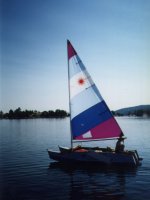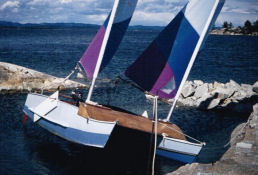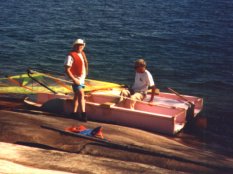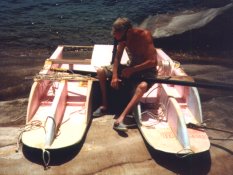Boats
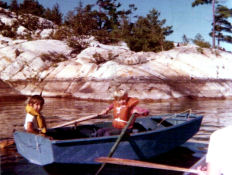 This
is a 1969 shot of Blue Boy with Travis Whitaker in back and Marc Nichols rowing.
This is a sailing dingy that Jim Whitaker built with his dad in about
1955. Dave Whitaker was about 12 at the time.
This
is a 1969 shot of Blue Boy with Travis Whitaker in back and Marc Nichols rowing.
This is a sailing dingy that Jim Whitaker built with his dad in about
1955. Dave Whitaker was about 12 at the time.
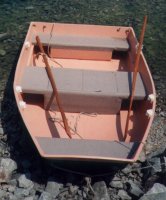 This
is the last boat that Dave built and, like the first boat he ever watched being built, it is a dingy but
while the first one was someone else's design, this one is all Dave. It is
made from a plywood vainer covered with fiberglass. It features 3 sets of
oar locks to facilitate rowing in various positions. It also has a flat
bottom with rocker, rather than a slight V like Blue Boy had, to give it added
stability.
This
is the last boat that Dave built and, like the first boat he ever watched being built, it is a dingy but
while the first one was someone else's design, this one is all Dave. It is
made from a plywood vainer covered with fiberglass. It features 3 sets of
oar locks to facilitate rowing in various positions. It also has a flat
bottom with rocker, rather than a slight V like Blue Boy had, to give it added
stability.
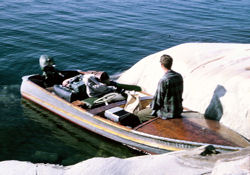 This boat was not home built but it is an important one in the history of the Island so it is included here. It originally had a 10 horse power
motor which was not only powerful enough to get to and from the island but it even pulled water skiers. I have skied behind it. Of course I only weighed about half of what I way now and we used extra wide skies but it still could get us up. This boat was the principle boat used when the cabin was being built and for a long time afterwards. This picture was taken in 1965. David Whitaker is the one in the boat. It looks like we are getting ready to head back to the big city.
This boat was not home built but it is an important one in the history of the Island so it is included here. It originally had a 10 horse power
motor which was not only powerful enough to get to and from the island but it even pulled water skiers. I have skied behind it. Of course I only weighed about half of what I way now and we used extra wide skies but it still could get us up. This boat was the principle boat used when the cabin was being built and for a long time afterwards. This picture was taken in 1965. David Whitaker is the one in the boat. It looks like we are getting ready to head back to the big city.
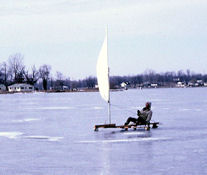 Not all Dave's boats were "boats" This ice boat was built in the 1965-66 winter
with his friend Bill Frisinger. It was made with a sail off a canoe, the runners off a pair of ice skates, and a runner made from a piece of angle
iron. The basic frame was a couple of 2 by 6's.; It was steered with
Not all Dave's boats were "boats" This ice boat was built in the 1965-66 winter
with his friend Bill Frisinger. It was made with a sail off a canoe, the runners off a pair of ice skates, and a runner made from a piece of angle
iron. The basic frame was a couple of 2 by 6's.; It was steered with
a simple bell crank mechanism. It was definitely Dave's fastest but one of the least elegant.
Dave
is usually tying to push boat design technology forward in some way but this project
was an exception. Here he carved
out a log to make a canoe, using only an ax, as he did not have an adz. Due to it's inherently round bottom, this craft
is at the other end of boat stability from the one above. (1969)
Dave is the one in the canoe.
This
picture of the harbor was taken in about 1972 (The harbor was blasted out in 1970)
There are a number of boats of interest here. The sailboat (a caïque) is a
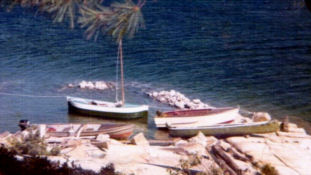 boat Dave made from used plywood. He wrote a story
of his buccaneer fantasies while sailing it in, Fiberglass
Pirate Ships. The white boat in front of it is a plywood kit boat that
Dave
built with his dad in the late 1950's. It was fiberglassed
by Bob Richardson, Dave's brother-in-law. The green boat is actually a fiberglass square
ended canoe that Dave built by putting fiberglass over an aluminum canoe that
was covered with wax paper so the fiberglass could be separated. The
canoe was built in the 1960s. The power boat in the lower left is the original
aluminum boat they used for basic transportation to and from the island.
It originally had a 10 horse outboard which was all anyone needed by definition of the
times. I had even skied behind it. Of course I weighed half of what I
do now and used extra wide skis. It was upgraded to a 20 horse by the time
this picture was taken.
boat Dave made from used plywood. He wrote a story
of his buccaneer fantasies while sailing it in, Fiberglass
Pirate Ships. The white boat in front of it is a plywood kit boat that
Dave
built with his dad in the late 1950's. It was fiberglassed
by Bob Richardson, Dave's brother-in-law. The green boat is actually a fiberglass square
ended canoe that Dave built by putting fiberglass over an aluminum canoe that
was covered with wax paper so the fiberglass could be separated. The
canoe was built in the 1960s. The power boat in the lower left is the original
aluminum boat they used for basic transportation to and from the island.
It originally had a 10 horse outboard which was all anyone needed by definition of the
times. I had even skied behind it. Of course I weighed half of what I
do now and used extra wide skis. It was upgraded to a 20 horse by the time
this picture was taken.
 This
is the first catamaran Dave had. I liked it because it was easy to sail alone
but would carry 2 easily and was basically a no hassle boat with good performance.
I think Dave though BORING, I can do better so he shortly started designing cats
which were substantially more innovative. The first was a hydrofoil
cat. This turned out to be pushing the envelope too far for even
Dave. I do not have a picture of this boat, probably because it spent so
little time in the water. The catamaran below is Dave's next boat.
This
is the first catamaran Dave had. I liked it because it was easy to sail alone
but would carry 2 easily and was basically a no hassle boat with good performance.
I think Dave though BORING, I can do better so he shortly started designing cats
which were substantially more innovative. The first was a hydrofoil
cat. This turned out to be pushing the envelope too far for even
Dave. I do not have a picture of this boat, probably because it spent so
little time in the water. The catamaran below is Dave's next boat.
This is Dave's twin sailed catamaran. It looks like it is sailing on one sail here but it can carry two, one on each hall. The boat breaks down into 2 separate hulls, a front deck and a main deck. All the connections can be worked by a person with limited strength. The boat is entirely of Dave's design.
I will never forget the maiden voyage. I had the "privilege" of accompanying Dave on it. We had assembled the boat on the low rocks on the south side of the island near the boat house. The wind was blowing from the west and seemed fairly genital standing on the south shore. We decided to give it a try.
We launched the boat and hoisted both sails. Once we got out of the lee of the island we discovered the wind was considerably stronger than I had anticipated. Our first objective was to get back to the island. Unfortunately the sideboards were further forward than optimum so the boat was VERY hard to turn into the wind. This also meant that there was a lot of load on the twin rudders which were made of un-reinforced sheet aluminum. Before we could make any headway in coming about, one rudder failed completely and the other bent quite a bit. I grabbed a paddle to rudder with and Dave concentrated on the sails. A nearby fisting boat, seeing our distress gave us a tow so we could come about.
The next challenge was to get back to the island which was more up wind than I would have liked. We sailed as close to the wind as we could, hopping to make the Island. Dave knew that the island slightly down wind of ours was occupied but I did not, so I was really worried. There wasn't anyone else on our island. With Dave's sailing skill we did make it back to the island.
As Dave suspected, moving the sideboards back completely corrected the problem so the boat went on to a long and illustrious career as Dave's most successful homebuilt sailboat.
This is Dave's last catamaran. It was built in 1997 out of Styrofoam sheets and reinforced with fiberglass set in Epoxy where necessary. It is intended to be very light and fast. Dave is the one in the catamaran with Bill Frisinger looking on.
Here Dave is working on his new cat. It has yet to be painted. Dave goes to extremes to save weight but he does use paint.
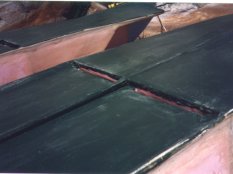 Here is a detail of the
bottom of one of the hulls. You can see the slots to permit air to form bubbles
underneath to reduce friction when the boat is planning. After the slots you can
see side rails on the bottom to keep the bubbles under the hall.
Here is a detail of the
bottom of one of the hulls. You can see the slots to permit air to form bubbles
underneath to reduce friction when the boat is planning. After the slots you can
see side rails on the bottom to keep the bubbles under the hall.
Dave liked to write articles for local newsletters. Double click HERE for one titled "An Old Salt's Late Summer Saga" written in 2001 about his experiences sailing from Grand Travers Bay up to Lake Superior and back.
Rev9/5/10
